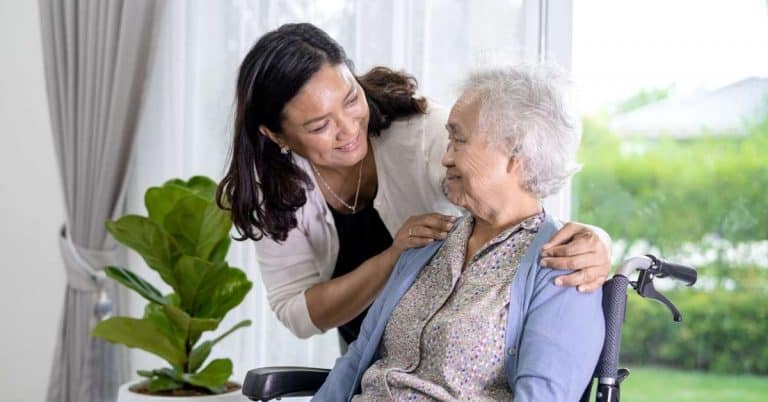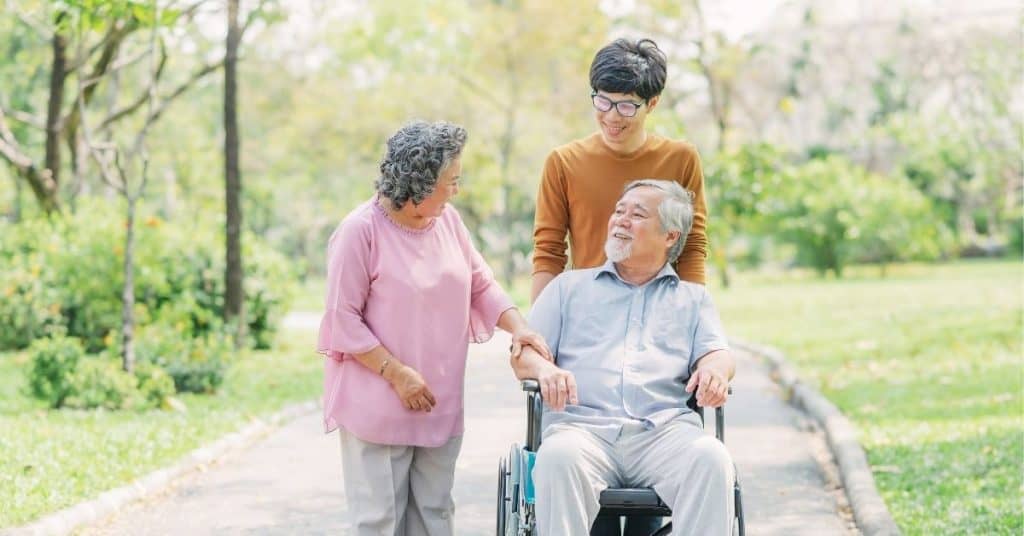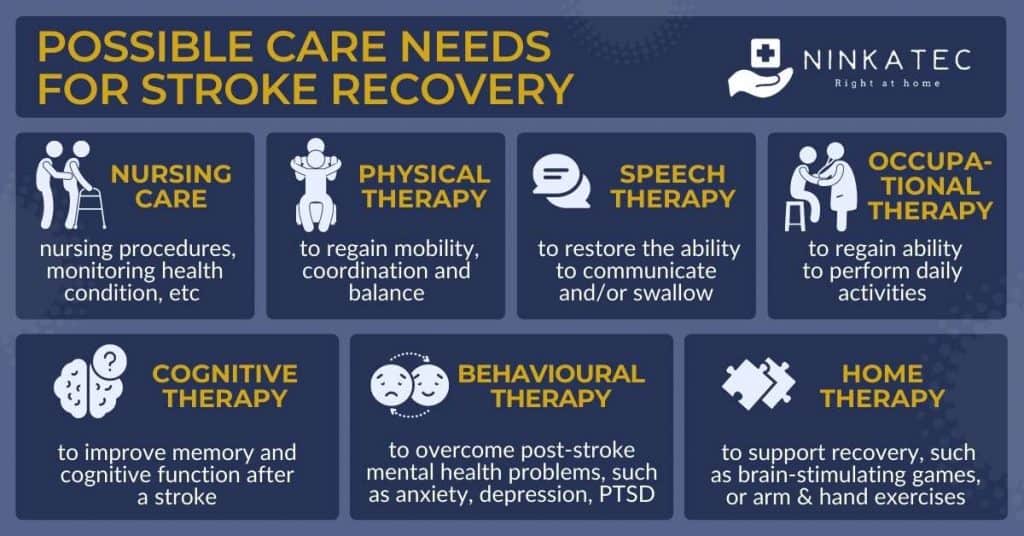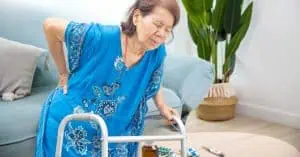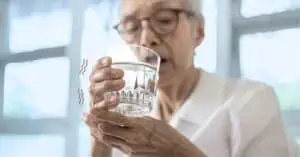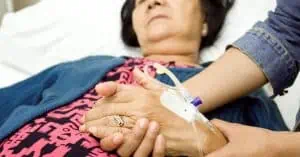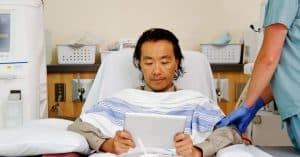Table of Contents
1. Why does a stroke cause long-term effects?
Strokes are the result of blood flow interruption to a certain region of the brain due to the formation of materials such as fat and cholesterol inside the blood vessel, or the migration of a clot from a distant body part.
The most common cause of strokes is blockage due to a clogged artery, cutting off blood supply to the brain. This is known as ischaemic stroke. Another type of stroke - known as hemorrhagic stroke - happens when there is bleeding from an artery in the brain, causing pressure on the surrounding parts of the brain.
In both types of strokes, brain tissues can be damaged quickly. It is estimated that the brain ages by 3.6 years each hour after an ischaemic stroke. Cognitive function deteriorates even more rapidly, at double the rate of overall brain aging during a stroke. Without immediate medical care, a stroke can cause deaths, or irreversible damages to the brain and the body. Stroke survivors often spend months or years in rehabilitation to get back to the life before the stroke, with various levels of success.
In this article, we will discuss the common long-term effects of strokes, the role of palliative care in long-term stroke recovery for stroke survivors, and how to provide palliative care to a stroke patient at home to improve their quality of life, as well as that of the caregiver and family members.
2. Common long-term effects of strokes
Strokes often have effects on the patient, depending on which part of the brain was affected and how long blood supply to the brain was interrupted. Effects range from temporary to long-term or permanent, from physical to emotional and mental changes. Below are commonly seen long-term effects after strokes:
2.1. Physical effects
- Weakness or paralysis on one side of the body, resulting in difficulty in walking, moving independently or balancing in many cases.
- Difficulties with swallowing or eating.
- Changes in physical ability to carry out daily activities such as holding items or doing exercise.
- Physical pain, often due to damage to tissues or nerves.
- Spasticity, causing muscle stiffness, or spasm in severe cases.
- Other symptoms such as fatigue, insomnia, incontinence, impaired vision, seizures, etc.
2.2. Side effects affecting communication: Depending on the part of brain that is affected during the stroke, patients may experience one or more of the following:
- Difficulties with finding words and speaking.
- Difficulties understanding what others are saying.
- Slurred or muffled speech.
- Trouble with reading and writing.
2.3. Memory and cognitive side effects
- Memory loss
- Difficulties with learning and understanding new information
- Mixing up information and details
2.4. Side effects affecting personality and emotion
- Anxiety and excessive worrying, often stemming from life changes after a stroke.
- Depression (also called post-stroke depression, or PSD).
- Changes in behavior and personality, such as becoming aggressive or impulsive or withdrawn.
- Other personality or behavioral changes such as uncontrolled crying or laughing, and mood swings.
3. Stroke rehabilitation & recovery from long-term effects of stroke
Stroke rehabilitation process starts after the doctor has stabilised the condition. The first few days or weeks are typically spent in the hospital under the observation of doctors and stroke rehabilitation specialists. Patients then continue recuperation at home or their place of residence for as long as necessary.
Studies reveal that stroke recovery is most rapid within the first 3-4 months, the first 4 weeks of which is when patients make the most noticeable progress. This is also the period when a recurrent stroke is likely to happen. An important part of stroke recovery therefore is to prevent a recurrence. Depending on the cause of the stroke and risk profile of the patient, doctors may prescribe certain medications or advise regular monitoring to reduce the chance of a secondary stroke.
The main purpose of stroke rehabilitation is to retrain the brain and the body to perform the functions that are affected during a stroke. Though the part of the brain that is damaged during a stroke cannot be recovered, the healthy part of the brain can be trained and rewired to form new connections, thereby helping the stroke patients to regain the lost functions.
Post-stroke rehabilitation therapies may include:
- Physical therapy to regain mobility, coordination and balance function. Depending on individual situations, rehabilitation goals can be to walk without using walking aid, or to use a wheelchair and be able to transfer to and from the wheelchair independently. The physical therapist will agree with the stroke patient on the goal and work out a training plan to achieve such a goal.
- Speech and language therapy to restore the ability to communicate (e.g., aphasia), and to swallow if the patient has difficulty swallowing (dysphagia).
- Occupational therapy to regain the ability to perform daily activities such as bathing, toileting, dressing, feeding, preparing meals for oneself.
- Cognitive therapy to improve memory and cognitive functions after a stroke
- Behavioural therapy to help stroke patients to overcome social challenges when interacting with other people, and other mental health problems.
- Occupational therapy: these are additional training exercises set by doctors or rehabilitation specialists for stroke patients to carry out at home to support the recovery process. For example, brain-stimulating games, light swimming exercises, or arm and hand exercises that patients can safely conduct by themselves.
Aside from the extent of brain damage incurred, age, overall health condition and commitment to training can also affect the outcome of stroke rehabilitation. For example, younger adults can recover faster and to a greater extent than older adults. Stroke patients with comorbidities are known to have more challenges recovering. However, with motivation, commitment and adequate medical care, patients can increase their chance of a fuller recovery.
4. Managing post-stroke paralysis and muscle weakness
The most common symptoms of stroke include paralysis and weakness that affect one side of the body. In severe cases, patients could become disabled. In other cases where patients could recover and move around on their own, spasms, pain, and restricted range of motion are frequent complaints. Patients also experience loss of coordination - which makes daily activities such as dressing, bathing difficult, and poor balance - which makes them prone to falls and injuries.
When you work with a team that specialises care for stroke, you will receive information about the nature of your paralysis and muscle weakness –the possibility of improvement, and the general management plan to deal with your issues. The care team will assess the patient and discuss the goals and objectives of care with the stroke patient and their family. It is important for the family to be part of the care team, as they will play a substantial role in providing assistance, support and motivation to the stroke patients during their loved one’s recovery process after a stroke.
Medications and other therapeutic approaches may also be used to improve the overall well-being for the stroke patient. For instance, if the patient suffers from severe pain that interferes with their daily lifestyle, the palliative care specialist may suggest medication that block nerve reactions, which will effectively relieve the pain.
5. Handling post-stroke communication difficulties
The processes involved in communication - speaking, listening, and understanding - are complex brain functions. It is estimated that 1 in every 3 stroke survivors have challenges with communication, which may include their ability to read and write as well.
When a stroke affects communication, recovery often requires the specialty of a speech-language pathologist. Once the type of communication issue is identified and a communication goal has been agreed with the patient, the speech therapist will work out a recovery plan. In case progress is slow, the speech pathologist will collaborate with the rest of the care team to identify the reasons and adjust the rehabilitation plan.
Caregivers and family members can also receive advice or training on how to communicate more effectively with your loved one suffering from communication problems after a stroke. For example, slowing down when you speak, making eye contact, giving time for answers, are some of the helpful tips in communication for families and friends of stroke patients.
If the muscles of the throat get damaged and dysphagia (difficulty swallowing) develops, which may have serious impact on nutrition intake for stroke patients, speech pathologists can also help. In case the nutritional need cannot be met by normal feeding through the mouth, the palliative care team may suggest a feeding tube and nursing care for the stroke patient, while the speech therapist works to improve throat muscle function. Read more about eating challenges after stroke and how to boost nutrition for stroke patients in our article here.
In all cases, the care team will help the patient and family understand in advance the pros and cons of each measure, whether they are temporary and permanent, and possible complications to watch out for, among other concerns.
6. Dealing with mental, emotional and personality changes after a stroke
The brain controls our emotions, behaviours and awareness. The obstruction of vital blood vessels that supply important regions of the brain can cause drastic behavioural changes, manifesting as irrational and unexpected actions or speech. After a stroke, these changes can manifest as various symptoms ranging from headaches, forgetfulness, insomnia, to anxiety, depression and inappropriate behaviour. The psychologist will be able to assess severity of symptoms and recommend medications and therapies to improve them.
The care team for stroke will discuss and agree with the stroke patient and family on a set of cognitive goals and social skill goals to work towards. Besides providing direct care, they will also be able to inform stroke patients and their families about the benefits and potential side effects of the treatments and the purpose behind their use, thanks to their knowledge and experience with post-stroke depression and other related issues.
Furthermore, with the goal of improving the well-being for both the patient and the family, medical care also supports the emotional need of family members as they learn to deal with a stroke patient at home. A stroke can be a life-changing event not just for the patient but also for the family members. Working with a care team, caregivers and family members will have someone to share their needs, worries and concerns with. Depending on the situation, you can expect counselling help and/or useful tips and advice to manage the situation and improve your
7. How palliative care can help stroke patients
7.1. Stroke patients benefit from a multi-disciplinary care team, including palliative care physicians
Due to the wide range of side effects that strokes may cause, people recovering from a stroke often need support from a multidisciplinary medical team, including:
- Neurologists
- Psychiatrists
- Rehabilitation nurses
- Physiotherapist and/or occupational therapists
- Speech therapists
Once the medical condition of a stroke patient has stabilised and no further improvement in symptoms can be expected, palliative care can support the patient together with the medical team. The palliative care physician can help clarify the stroke patient’s goals of care and extent of care which are important in further care coordination in the long term. Of key importance is planning for complications and acute episodes (such as infection – see next section) that can happen periodically to patients who are on long term care for strokes.
7.2. Palliative care for managing complications and acute episodes that occur in the long term care of stroke patients
Once the initial stroke has stabilized and the patient is cared for at home, many complications can arise. How doctors manage these episodes depend to a large extent on the patient’s care objectives. With the help of a palliative care physician, these objectives can be clarified and communicated to the entire care team. For example, an elderly stroke patient who is bedridden and has failing organs may decide that he/she prefers treatment at home in the event of a serious complication (new stroke, heart attack, infection, etc.).
This is where the palliative care physician’s role becomes the focus. For such a patient, if he/she suffers from a heart attack, the focus of care may be to relieve the symptoms (chest pain, breathlessness, etc.) rather than to consider hospitalization or procedures such as stents to relieve blocked arteries. Another common situation is when stroke patients develop an infection. If the patient (or family) has decided to procced with palliative care, medical management may focus on relieving symptoms rather than trying to cure the infection.
When such situations occur, not only is it difficult for the patient but the family may also be facing a stressful situation. In addition to relieving physical symptoms, the palliative team helps to address mental, spiritual and social care needs for stroke patients, thereby elevating the patient’s overall well-being.
Research shows that stroke patients who receive palliative care early on report better quality of life. Their family members also benefit from having the palliative care team to guide them with necessary medical knowledge, and consulting with when they have to make decisions with, or for their loved one. Social workers, who are a part of the palliative team, can also lend a helping hand to both patients and families.
Above are important aspects of palliative care that makes it helpful for stroke recovery. To learn more about the role, benefits, and limitations of palliative care in general, check out our article on palliative care in Singapore.
8. Setting goals and objective for long term stroke patients with the help of palliative care physicians
Communication is a cornerstone in palliative care. By creating a healthy environment between the stroke patients, their loved ones, the doctor in charge, palliative care experts help to set a strong foundation of care and support for stroke patients. Most importantly, with their experience and expertise, a palliative care team specialising in stroke will help you set realistic expectations to achieve and discuss your goals of care. While it is crucial to have a positive mentality and the willpower to get better, it is never a good idea to set the bar too high, only to be disappointed later in the process.
Recovering from a stroke requires substantial support from various sources, often over a prolonged period of time and sometimes with unexpected turn of events. Having access to palliative care can help you navigate the healing journey effectively and confidently, for both the patient and the family, by knowing what to expect and having someone reliable to turn to every step of the way.
9. How to care for a stroke patient at home as a family member or friend
Now that we understand the role of palliative care in taking care of stroke patients, let’s discuss the potential role of a family member or loved one in assisting a patient with stroke. For many patients, recovering from a stroke is an extremely challenging process. They need all the support they can get from families and friends to get back to life before the stroke.
If you have a friend or a loved one with a stroke, here’s how to take care of them:
- Provide support
The first thing you can do is to aid them with their rehabilitation exercises in between sessions, as this plays a crucial role in recovering the lost functions. You also need to provide emotional support and reassurance since patients tend to overthink their condition and always focus on the worst-case scenario.
Keep in mind that despite the severe damage that can be caused by strokes, one of the major part to post-stroke care is to set short and long-term goals for patients, which pushes them to attend physiotherapy sessions and work hard to recover. Therefore, you should always act as the motivator to keep them going.
- Adapt to their behavioural changes
As discussed above, stroke may cause unexpected emotional and behaviour changes. For instance, they may develop resentful feelings for no apparent reason. This can be very frustrating or overwhelming for families and close friends, causing them distress along the way.
However, you must remember that these changes are often temporary, and they will likely revert to their old self as the rehabilitation sessions progress. To ease this process, seek help from support groups or the palliative care team. It is also advisable for caregivers to take time off to take care of your physical and psychological needs whenever you require.
- Call on the professionals
Caring for a stroke patient can be extremely demanding, especially if the primary caregiver is a family member who has a full-time job. Remember, you can improve your loved one’s quality of life as well as your own by adding appropriate ‘equipment and tools’ to the house. It is useful to tap into professional help, such as getting respite care, hiring a professional caregiver, calling on nursing care service or palliative care specialist for stroke to ease your burden. The professionals will be able to provide the necessary physical and psychological support to your loved one, which will relieve the pressure from you.
10. Stroke care at home with Ninkatec
Caring for your loved ones after a stroke is an extremely important task to alleviate their sufferings and help them get back to life before stroke, as well as managing complications along the way. Hopefully, this article helps to shed some light on the processes needed to take care of stroke patients, especially the role of integrating palliative care in post-stroke recovery at home.
Ninkatec is one of the leading home care specialists in Singapore, with the technology and experience to provide 24/7 professional care to stroke patients in the comfort of their home. We take a patient-centric approach and provide palliative care that is personalised to each individual patient’s situation. For a private consultation on the stroke condition of your loved one, please feel free to call, email, WhatsApp us, or leave your contact in the form below.

